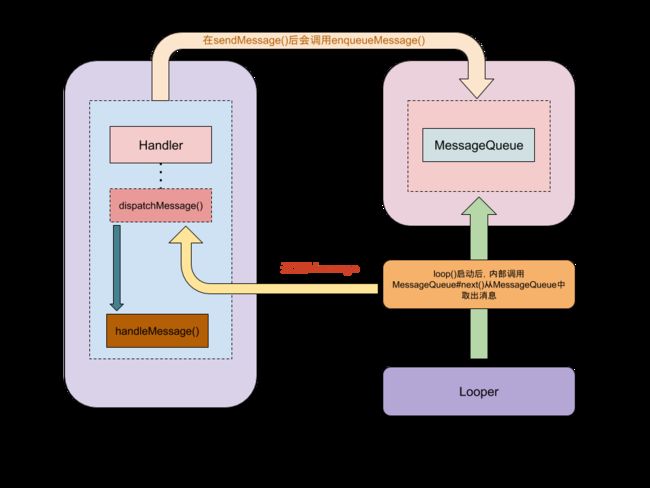在Android开发中,是不能在子线程中更新UI的,这一点想必大家都知道,但是,很多时候在子线程中访问了网络或做其它耗时处理后,希望可以把结果更新到UI中。于是,Android 中提供了一个Handler机制。它很好的解决了这个问题。
在分析Handler之前,先简单说下几个关键类:
- Handler:负责消息的发送和处理。
- Message:消息载体,用于保存消息的arg、内容等。
- MessageQueue:消息队列,用于存放消息载体Message。
- Looper:可以看成是一个消息轮询器,会不断的从MessageQueue中取出Message
1、Handler的使用
private Handler handler = new Handler(){
@Override
public void handleMessage(Message msg) {
super.handleMessage(msg);
if(msg.what == 1){
//接收消息并处理
}
}
};
new Thread(new Runnable() {
@Override
public void run() {
Message message = Message.obtain();
message.what = 1;
message.obj = "消息";
handler.sendMessage(message);
}
}).start();
从代码看,Handler的使用很简单,在子线程中创建一个Message对象,通过handler.sendMessage()发送,然后在Handler内的handleMessage()中进行处理。但是,在实际开发中创建Handler时,建议大家选用以静态内部类的方式来创建Handler,这样可以降低内存泄漏的发生。接下来看一下Handler的构造函数。
public Handler() {
this(null, false);
}
public Handler(Callback callback, boolean async) {
if (FIND_POTENTIAL_LEAKS) {
final Class klass = getClass();
if ((klass.isAnonymousClass() || klass.isMemberClass() || klass.isLocalClass()) &&
(klass.getModifiers() & Modifier.STATIC) == 0) {
Log.w(TAG, "The following Handler class should be static or leaks might occur: " +
klass.getCanonicalName());
}
}
mLooper = Looper.myLooper();
//1
if (mLooper == null) {
throw new RuntimeException(
"Can't create handler inside thread that has not called Looper.prepare()");
}
mQueue = mLooper.mQueue;
mCallback = callback;
mAsynchronous = async;
}
在第二个构造函数注释1处,可以发现:如果当前线程中mLooper 为null,会抛出RuntimeException,这也就是为什么在子线程中创建Handler需要先Looper.prepare()的原因。而主线程不用我们手动创建Looper对象,是因为在启动程序时已经为主线程创建了Looper对象。看下面一段ActivityThread类中的main方法:
public static void main(String[] args) {
//省略代码...........
//为主线程创建一个Looper对象
Looper.prepareMainLooper();
ActivityThread thread = new ActivityThread();
thread.attach(false);
if (sMainThreadHandler == null) {
sMainThreadHandler = thread.getHandler();
}
if (false) {
Looper.myLooper().setMessageLogging(new
LogPrinter(Log.DEBUG, "ActivityThread"));
}
// End of event ActivityThreadMain.
Trace.traceEnd(Trace.TRACE_TAG_ACTIVITY_MANAGER);
//启动消息轮询
Looper.loop();
throw new RuntimeException("Main thread loop unexpectedly exited");
}
在程序启动时,不单单是为主线程创建了一个Looper对象,而且还启动的消息轮询器Looper.loop()。接下来我们先分析sendMessage(),看看消息是怎么加进MessageQueue中的。
2、sendMessage()分析
public final boolean sendMessage(Message msg)
{
return sendMessageDelayed(msg, 0);
}
public final boolean sendMessageDelayed(Message msg, long delayMillis)
{
if (delayMillis < 0) {
delayMillis = 0;
}
return sendMessageAtTime(msg, SystemClock.uptimeMillis() + delayMillis);
}
public boolean sendMessageAtTime(Message msg, long uptimeMillis) {
MessageQueue queue = mQueue;
if (queue == null) {
RuntimeException e = new RuntimeException(
this + " sendMessageAtTime() called with no mQueue");
Log.w("Looper", e.getMessage(), e);
return false;
}
return enqueueMessage(queue, msg, uptimeMillis);
}
private boolean enqueueMessage(MessageQueue queue, Message msg, long uptimeMillis) {
msg.target = this;
if (mAsynchronous) {
msg.setAsynchronous(true);
}
return queue.enqueueMessage(msg, uptimeMillis);
}
通过上面一系列代码下来,可以发现:sendMessage()发送消息后,最后会调用MessageQueue的enqueueMessage()方法,uptimeMillis是发送消息的时间。
//MessageQueue类的enqueueMessage()
boolean enqueueMessage(Message msg, long when) {
//1
if (msg.target == null) {
throw new IllegalArgumentException("Message must have a target.");
}
if (msg.isInUse()) {
throw new IllegalStateException(msg + " This message is already in use.");
}
synchronized (this) {
//如果调用了Looper#quit()或Looper#quitSafely(),会结束轮询,并释放资源
if (mQuitting) {
IllegalStateException e = new IllegalStateException(
msg.target + " sending message to a Handler on a dead thread");
Log.w(TAG, e.getMessage(), e);
msg.recycle();
return false;
}
//添加消息
msg.markInUse();
msg.when = when;
Message p = mMessages;
boolean needWake;
if (p == null || when == 0 || when < p.when) {
// New head, wake up the event queue if blocked.
msg.next = p;
mMessages = msg;
needWake = mBlocked;
} else {
// Inserted within the middle of the queue. Usually we don't have to wake
// up the event queue unless there is a barrier at the head of the queue
// and the message is the earliest asynchronous message in the queue.
needWake = mBlocked && p.target == null && msg.isAsynchronous();
Message prev;
for (;;) {
prev = p;
p = p.next;
if (p == null || when < p.when) {
break;
}
if (needWake && p.isAsynchronous()) {
needWake = false;
}
}
msg.next = p; // invariant: p == prev.next
prev.next = msg;
}
// We can assume mPtr != 0 because mQuitting is false.
if (needWake) {
nativeWake(mPtr);
}
}
return true;
}
在上面的代码注释1处,首先判断msg.target是否为null,根据Handler中的enqueueMessage()方法,可以发现msg.target是Message 内的一个Handler类变量。然后判断消息轮询是否结束,如果没有,则加入消息队列。到此,消息的添加就完毕了。
3、Looper分析
首先,Looper的创建
public static void prepareMainLooper() {
prepare(false);
synchronized (Looper.class) {
if (sMainLooper != null) {
throw new IllegalStateException("The main Looper has already been prepared.");
}
sMainLooper = myLooper();
}
}
public static void prepare() {
prepare(true);
}
private static void prepare(boolean quitAllowed) {
if (sThreadLocal.get() != null) {
throw new RuntimeException("Only one Looper may be created per thread");
}
//1
sThreadLocal.set(new Looper(quitAllowed));
}
prepareMainLooper()是在主线程创建Looper时调用的,最终也是调用了prepare()。在上面代码的注释1处,sThreadLocal是ThreadLocal的一个实例对象。sThreadLocal内部以当前线程作为key,创建的Looper实例作为value。主要在ThreadLocal的内部类ThreadLocalMap中实现。这样使得每个线程都有一个独立的Looper实例副本。
Looper#loop()
public static void loop() {
final Looper me = myLooper();
if (me == null) {
throw new RuntimeException("No Looper; Looper.prepare() wasn't called on this thread.");
}
final MessageQueue queue = me.mQueue;
// Make sure the identity of this thread is that of the local process,
// and keep track of what that identity token actually is.
Binder.clearCallingIdentity();
final long ident = Binder.clearCallingIdentity();
for (;;) {
//1
Message msg = queue.next(); // might block
if (msg == null) {
// No message indicates that the message queue is quitting.
return;
}
// This must be in a local variable, in case a UI event sets the logger
final Printer logging = me.mLogging;
if (logging != null) {
logging.println(">>>>> Dispatching to " + msg.target + " " +
msg.callback + ": " + msg.what);
}
final long slowDispatchThresholdMs = me.mSlowDispatchThresholdMs;
final long traceTag = me.mTraceTag;
if (traceTag != 0 && Trace.isTagEnabled(traceTag)) {
Trace.traceBegin(traceTag, msg.target.getTraceName(msg));
}
final long start = (slowDispatchThresholdMs == 0) ? 0 : SystemClock.uptimeMillis();
final long end;
try {
//2
msg.target.dispatchMessage(msg);
end = (slowDispatchThresholdMs == 0) ? 0 : SystemClock.uptimeMillis();
} finally {
if (traceTag != 0) {
Trace.traceEnd(traceTag);
}
}
if (slowDispatchThresholdMs > 0) {
final long time = end - start;
if (time > slowDispatchThresholdMs) {
Slog.w(TAG, "Dispatch took " + time + "ms on "
+ Thread.currentThread().getName() + ", h=" +
msg.target + " cb=" + msg.callback + " msg=" + msg.what);
}
}
if (logging != null) {
logging.println("<<<<< Finished to " + msg.target + " " + msg.callback);
}
// Make sure that during the course of dispatching the
// identity of the thread wasn't corrupted.
final long newIdent = Binder.clearCallingIdentity();
if (ident != newIdent) {
Log.wtf(TAG, "Thread identity changed from 0x"
+ Long.toHexString(ident) + " to 0x"
+ Long.toHexString(newIdent) + " while dispatching to "
+ msg.target.getClass().getName() + " "
+ msg.callback + " what=" + msg.what);
}
msg.recycleUnchecked();
}
}
在注释1处,可以发现:looper利用for(;;)进入了无限循环。调用MessageQueue 中next()方法,会向MessageQueue 中取出消息,如果没有消息存在,next()会处于阻塞状态(这里是由底层实现的,调用了本地方法nativePollOnce()),当有消息返回时,会走到注释2处,调用Handler的dispatchMessage()进行分发消息。
public void dispatchMessage(Message msg) {
if (msg.callback != null) {
handleCallback(msg);
} else {
if (mCallback != null) {
if (mCallback.handleMessage(msg)) {
return;
}
}
handleMessage(msg);
}
}
handleCallback()是在调用Handler#post(Runnable run)或者是设置了msg.callback时回调的。最后回调了 handleMessage()。
完篇~
